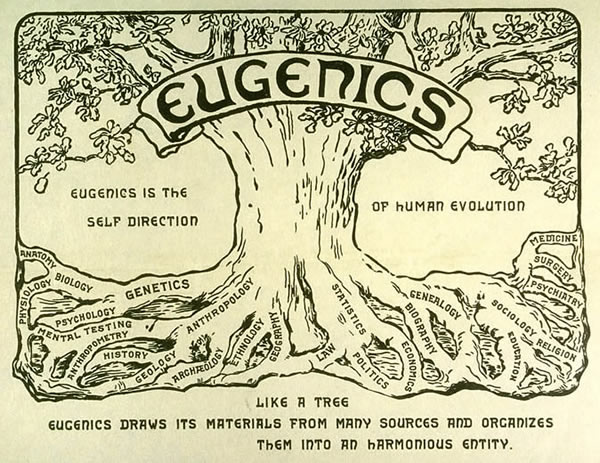 |
| Eugenics |
Sir Francis Galton, a cousin of Charles Darwin, coined the term and concept of eugenics in 1883. Eugenics, often defined as "well-born," was an effort to apply Darwinian evolution and Gregor Mendel's recently recognized genetic discoveries to the physical, mental, and moral improvement of human beings.
Eugenics gained many supporters in the progressive-era United States, Canada, and much of Europe. But the concept was riddled with class and racial biases that inflicted harm on thousands of supposedly "inferior" humans. When the excesses of Adolf Hitler's World War II eugenics programs became known, this effort at human engineering fell into disrepute.
Galton was a respected scientist and statistician, but his eugenics notions were based less on evolution than on Social Darwinism, a philosophy that conveniently justified growing inequities in industrializing societies.
  |
Nations could no longer wait for evolution to weed out the weak and stupid; rather, experts would facilitate the process of improving the race, by which most eugenicists meant white northern Europeans.
Positive eugenics tried to encourage "superior" men and women to produce superior offspring. (The Galtons were childless.) Negative eugenics went much further. It proposed to discourage "defective" humans from reproducing at all.
Soon, eugenics agencies and research facilities were springing up. A eugenics laboratory, later named in Galton's honor, was founded at London's University College in 1904. In the United States Charles Davenport created a Eugenics Record Office on Long Island.
U.S. president Theodore Roosevelt, fearing "race suicide," heartily approved of this burgeoning movement to weed out the "unfit." The state of Indiana in 1907 was the first to pass a eugenics sterilization law.
Buck v. Bell, a eugenics sterilization case from Virginia, came before the U.S. Supreme Court in 1927. Speaking for eight of the nine justices, Oliver Wendell Holmes, Jr., ruled in favor of the state.
 |
| US Eugenics |
Carrie Buck, he noted, "is a feeble-minded white woman . . . the daughter of a feeble-minded mother ... and the mother of an illegitimate feeble-minded child," adding, "Three generations of imbeciles are enough." By 1933 28 states had sterilized more than 16,000 unconsenting women, men, and children.
In Canada interest in eugenics peaked among English speakers during the Great Depression, when the poor and sick seemed an impossible burden. The Soviet Union and many European nations also promoted fitter families while trying to minimize the "unfit."
Everywhere the poor and uneducated, racial and ethnic minorities, and criminals were overwhelmingly beneficiaries of "genetic cleansing." But none took eugenics as far as Nazi Germany, where Hitler copied many aspects of U.S. eugenics practices and passed laws in the 1930s that foreshadowed the elimination of millions of Jews, Gypsies, gays, and others considered unfit.
In the wake of these atrocities, most eugenics organizations disbanded or rethought their goals. In 1942 the Supreme Court struck down involuntary sterilization of criminals; in 2001 Virginia apologized for Buck and other eugenics interventions.
As genetic science has expanded dramatically, the ethics of genetic improvement remains a very touchy topic. Birth control pioneers Margaret Sanger of the United States and Marie Stopes in Britain were both ardent eugenicists, leading today's abortion foes to distrust the underlying aims of family planning. New technologies raise the specter of prenatal engineering for "perfect" babies—a concept Galton did not precisely foresee but would probably have applauded.